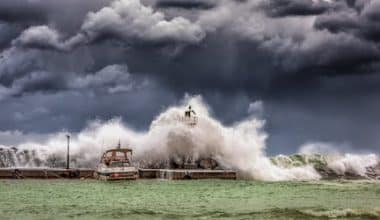Are you looking for flood insurance and wondering what to expect cost-wise? Well, the first thing you should know is that the rate you get will depend on various factors. These include where you live and the building characteristics of your home or office building, among others.
Too many homeowners think they don’t need flood insurance. Only about 5% to 15% of homeowners have it, according to the National Association of Insurance Commissioners. But 99% of counties in the U.S. are impacted by flooding, according to the most recent data from FEMA.
To make matters worse, many homeowners believe they’re already covered for flood damage by their homeowners’ policy. But a standard homeowners insurance policy won’t cover flood damage.
Without flood insurance, you could face a major financial disaster if your home gets hit by a flood. To put this in perspective, the average payout on a flood claim from the National Flood Insurance Program (NFIP) is $52,000, according to the most recent data from FEMA.
What Is Flood Insurance?
A flood insurance policy covers your house and your belongings for flood-related damage. It’s separate from a homeowners insurance policy, which usually doesn’t cover flood damage from problems like hurricanes and torrential rain.
In many places, a flood is considered a vis major event, and the damage or destruction it causes is uncovered if you do not get supplemental insurance.
Most homeowners who buy flood insurance buy it from the National Flood Insurance Program, but you may be able to buy a policy in the private market.
Flood insurance can cover problems such as:
- Storm surges.
- Inland flooding, such as rivers and streams overflowing during a storm.
- Flash floods.
Flood insurance through the NFIP has a 30-day waiting period before coverage goes into effect, meaning you can’t make a flood insurance claim for damage that occurred during the waiting period. Some private flood insurance companies have a shorter or no waiting period.
How Flood Insurance Works
A type of catastrophe insurance, a flood insurance policy is different than the basic hazard insurance coverage contained in a homeowners insurance policy. Flood insurance policies are available for all homes and commercial properties.
Standard homeowners insurance covers interior water damage, due to factors like storms or burst pipes. However, it generally doesn’t cover destruction or damage caused by floodwaters. Property owners who live in an area prone to floods usually need to get special insurance.
Flood insurance basically works like other insurance products. The insured (the property owner) pays an annual premium based on the property’s flood risk and the deductible they choose.
If the property or its contents are damaged or destroyed by flooding caused by an external event like rain, snow, storms, collapsed or failed infrastructure, the homeowner is covered. They receive cash for the amount of money required to repair the damage and/or rebuild the structure, up to the policy limit.
If your house and belongings are damaged or destroyed by a flood, you can file a claim with your flood insurance company and be covered up to your policy’s limit. For example, if you had an NFIP policy with $250,000 in building coverage, you would be covered up to that amount.
Some homeowners also purchase private flood insurance as an “excess” policy to provide additional coverage on top of their base NFIP policies.
Unlike a standard homeowners policy, flood insurance requires that a policyholder buy separate policies to cover a dwelling and its contents. A separate coverage rider is needed to cover sewer backup if the backup was not caused by the rising floodwaters.
The National Flood Insurance Program
The National Flood Insurance Program (NFIP) is managed by the Federal Emergency Management Agency (FEMA). It offers flood insurance to homeowners in participating communities and those in the NFIP-designated floodplains. The actual insurance policies are issued by private insurance companies, not by the NFIP or FEMA.
The Federal Emergency Management Agency (FEMA) updates maps of the flood zones in the U.S., the areas that are most likely to experience flooding. FEMA updates the zones as they change along with new and intensifying weather patterns. The zones are broken up into subsections for rating purposes. Properties that are located in zones B, C, and X run a moderate to low risk for flooding. Low risk means less than a 1% chance of annual flooding.
Properties that are located in zones designated with an A are considered high risk. They are broken down further, with descriptions of potential floodwater heights and estimated rates of occurrence over the course of a 30-year-mortgage. Properties that receive a V designation are similar to the ones located in zone A. These are high-risk areas that are positioned along the coast.
Some homeowners may be in Zone D, which indicates that a determination has yet to be made for the area. Flood zone maps are under continuous review to accommodate changing weather patterns and artificial changes to the environment such as dams and levees.
What does flood insurance cover?
Flood insurance can generally be broken into two main parts: Dwelling (your house) and contents (your belongings). You may be able to purchase a building-only policy, a contents-only policy, or both, depending on where you purchase your flood insurance from.
Note: Unlike homeowners insurance, flood insurance doesn’t provide additional living expenses coverage. A standard home insurance helps pay for lodging and extra costs like meals if you need to live elsewhere after a problem covered by your policy.
Dwelling coverage
Dwelling coverage, also called building coverage, pays to repair or rebuild your house after flood-related damage. For example, if flood water damages your electrical and plumbing systems, the dwelling coverage in a flood insurance policy would pay to repair or replace it.
Flood insurance through the NFIP caps dwelling coverage to $250,000. You may be able to buy higher amounts of dwelling coverage in the private market. For example, Flood Guard sells policies with up to $5 million in dwelling coverage and Neptune Flood Insurance offers up to $4 million in dwelling coverage.
Contents coverage
Contents coverage, also called personal property coverage, covers your personal belongings, such as furniture, clothing and appliances. For example, if flood waters destroy your living room furniture, the contents coverage within a flood insurance policy would pay to repair or replace the items.
An NFIP flood insurance policy caps contents coverage to $100,000. You may be able to buy higher content coverage through the private market.
What does flood insurance not cover?
Flood insurance doesn’t cover every type of water damage. A flood policy from the NFIP typically does not cover:
- Damage caused by burst pipes (that type of damage is covered under home insurance).
- Personal property outside of your building such as decks, patios, swimming pools, septic systems and landscaping.
- Preventable mold and mildew.
- Additional living expenses, such as hotel lodging, if your home is inhabitable.
- Damaged cars (the comprehensive portion of your car insurance policy covers flood-related car damage).
Cost of Flood Insurance
The NFIP regulates the pricing of flood insurance policies, and the cost will not differ between issuers. If you live in a flood zone or an NFIP-participating community, the NFIP can help you find an insurance agent.
To determine your policy cost your agent will look at factors like the location and structure of your home, including how near it is to a body of water and its elevation. Costs will also be affected by the type of coverage you have selected, such as replacement cost value versus actual cost value.
Factors such as the flood zone designation, the age of the property, and the number of floors can all impact pricing. A Preferred Risk Policy (a lower-cost flood insurance policy) provides both building and contents coverage for properties in moderate-to-low-risk areas for one price.8 Certain communities that have implemented flooding safeguards qualify for discounts under the NFIP, too.
As a result, annual premiums can vary widely.
With NFIP policies, the maximum for residential structures is $250,000 in building coverage and $100,000 in contents coverage. The maximum for businesses is $500,000 in building coverage and $500,000 in contents coverage
Average flood insurance costs by state
| State | Average dwelling insurance amount | Average contents insurance amount | Average annual flood insurance cost |
|---|---|---|---|
| Alabama | $180,069 | $50,803 | $772 |
| Alaska | $198,358 | $40,278 | $846 |
| Arizona | $197,542 | $39,400 | $674 |
| Arkansas | $123,554 | $26,863 | $691 |
| California | $219,551 | $53,999 | $807 |
| Colorado | $189,973 | $53,526 | $820 |
| Connecticut | $209,761 | $45,536 | $1,491 |
| Delaware | $217,839 | $58,651 | $918 |
| Florida | $209,103 | $64,276 | $699 |
| Georgia | $198,319 | $59,817 | $733 |
| Hawaii | $233,051 | $45,824 | $1,485 |
| Idaho | $189,620 | $47,329 | $738 |
| Illinois | $150,513 | $29,284 | $1,017 |
| Indiana | $135,845 | $27,655 | $876 |
| Iowa | $121,987 | $30,837 | $758 |
| Kansas | $125,793 | $32,968 | $737 |
| Kentucky | $115,426 | $21,992 | $790 |
| Louisiana | $183,483 | $58,053 | $710 |
| Maine | $184,992 | $48,727 | $1,035 |
| Maryland | $203,724 | $56,945 | $800 |
| Massachusetts | $207,315 | $46,303 | $1,429 |
| Michigan | $148,560 | $23,951 | $934 |
| Minnesota | $167,232 | $48,155 | $752 |
| Mississippi | $164,491 | $54,172 | $595 |
| Missouri | $121,190 | $26,836 | $774 |
| Montana | $155,733 | $43,702 | $755 |
| Nebraska | $134,110 | $22,932 | $840 |
| Nevada | $201,947 | $40,384 | $593 |
| New Hampshire | $177,946 | $39,074 | $1,065 |
| New Jersey | $212,545 | $41,592 | $1,158 |
| New Mexico | $161,119 | $26,719 | $797 |
| New York | $207,225 | $55,221 | $1,144 |
| North Carolina | $200,977 | $52,387 | $823 |
| North Dakota | $186,134 | $64,377 | $603 |
| Ohio | $128,257 | $28,130 | $849 |
| Oklahoma | $144,525 | $39,407 | $711 |
| Oregon | $194,808 | $45,042 | $844 |
| Pennsylvania | $138,472 | $34,671 | $900 |
| Rhode Island | $207,124 | $47,801 | $1,388 |
| South Carolina | $221,248 | $69,819 | $794 |
| South Dakota | $148,314 | $40,284 | $772 |
| Tennessee | $169,890 | $48,212 | $704 |
| Texas | $195,264 | $71,489 | $603 |
| Utah | $194,534 | $63,228 | $647 |
| Vermont | $156,916 | $37,390 | $1,017 |
| Virginia | $202,222 | $58,231 | $773 |
| Washington | $191,678 | $43,582 | $834 |
| West Virginia | $96,748 | $17,542 | $767 |
| Wisconsin | $142,222 | $32,373 | $856 |
| Wyoming | $174,909 | $46,680 | $846 |
| Source: Federal Emergency Management Agency. Costs include premiums and fees. | |||
Factors that determine cost
Common factors that determine flood insurance costs include a property’s flood risk, building characteristics, type of policy and deductible amount.
Flood risk
Flood insurance costs are largely based on your property’s flood risk. Homes that have a higher flood risk will pay more for homes with a low flood risk.
For example, FEMA’s Risk Rating 2.0 takes into account the elevation of your home, the foundation type, first-floor height, and the distance to water.
Building characteristics
Insurers will also factor in the physical characteristics of your building, such as:
- Building occupancy. The type and use of your building will be factored into your rates.
- The materials your home is made of. For example, masonry walls perform better in floods compared to wood frame walls, which can result in lower flood insurance rates.
- Number of floors. Buildings with more floors spread their flood risk compared to a building with one floor.
- Machinery and equipment. Elevating equipment such as hot water heaters and central air conditioning units above the first floor lowers the risk of damage to your machinery and equipment.
Type of policy
Your flood insurance policy coverage type influences rates. For example, you can buy a building-only policy, contents-only policy or both from the NFIP. You’ll pay more for flood insurance if you buy both building and contents coverage compared to a building-only policy.
Coverage types and amounts
How much coverage you buy influences costs. For instance, a private flood insurance policy that offers building coverage of $1 million will cost you more than an NFIP policy with $250,000 in building coverage.
Deductible amount
Similar to other types of insurance policies, a flood insurance policy will have lower costs if you have a higher deductible. An insurance deductible is subtracted from an insurance company claims payout, so if your house has $50,000 worth of flood damage and you have a $2,000 deductible, the insurer will pay you $48,000 for the damage.
Insurance company
Insurance companies don’t charge the same for coverage. You may find one flood insurer charges much higher rates for the same coverage than another insurance company. That’s why it’s vital to shop around and get flood insurance quotes from multiple insurers when looking for a private flood insurance policy.
Other Cost Factors
Where your home is located and how it relates to the community rating system discount or whether your house is on a barrier island can affect your NFIP flood insurance costs.
Risk Rating 2.0
FEMA introduced Risk Rating 2.0 to address inaccurate flood rates and the NFIP’s large debts. This new methodology no longer uses flood maps. Instead, rates are based on an individual property’s risk, such as the foundation type, elevation of the home and the distance to water. Risk Rating 2.0 is intended to produce the most accurate flood insurance costs, according to FEMA.
FEMA made the change to the pricing methodology, which had been used by the NFIP since it was introduced in 1968. This methodology relied on “Flood Insurance Rate Maps” (FIRMs) to determine flood insurance costs.
The problem with this model was that too many properties were inaccurately rated and the premiums were insufficient to cover flood claims, which led to massive debt for the NFIP.
When do I need flood insurance?
Flood damage is not covered by standard homeowners insurance, so if you’re concerned about flooding, you should look into flood insurance.
A Swiss Re survey exposes a common mistake among homeowners: 43% believe their home insurance policy will cover them for flood damage. However, homeowners’ insurance for water damage is generally limited to problems like burst pipes—not an inundation of water on the ground.
In some cases, you may be required to have flood insurance. For example, if you own a home or business and have a government-backed mortgage, you’ll be required to have flood insurance if you live in a high-risk flood area.
The price of flood insurance can turn off many homeowners who aren’t required to have it. However, having a flood insurance policy can provide immediate financial assistance so that you don’t have to wipe out your savings or take out a loan in order to rebuild.
Relying on federal disaster aid after a flood isn’t a good financial plan. Disaster aid can take months and isn’t offered after every flood. Disaster victims who don’t have insurance often rely on funds from the Disaster Loan Program of the Small Business Administration (SBA).
SBA loans can provide up to $200,000 for homeowners to repair their primary residences. In addition, homeowners and renters can receive up to $40,000 to repair personal property (such as furniture) or replace it. You’re expected to pay the loan back, although they have low-interest rates and can have long terms, such as 30 years.
When should I buy flood insurance?
If you live in a high-risk flood zone and have a mortgage, your lender may require that you have flood insurance, but coverage may be a smart choice even if you live in a low- or moderate-risk flood zone.
Homes outside of high-risk zones are still at risk of flooding. FEMA says that one-third of flood insurance claims are from low- or moderate-risk flood areas. Flood insurance costs are lower if your property has low flood risk.
FEMA flood insurance policies have set coverage limits, but if you feel you need more coverage, you can buy a private flood insurance policy as a supplement. Maybe the cost to rebuild your home is more than $250,000, which is the FEMA policy limit. Or you may need more than $100,000 in content coverage.
In those cases, check with private flood insurance companies and buy coverage that goes beyond FEMA flood policies.
How to get flood insurance
There are two ways to get flood insurance:
- The National Flood Insurance Program (NFIP) is the federal plan from FEMA. Most homeowners who have flood insurance get it from the National Flood Insurance Program. Your home insurance agent can process your application for a policy.
- Private personal flood insurance is available from some companies. They may have coverage options not available from FEMA so they can be good for people who have large or expensive properties, or who simply find the FEMA choices to be insufficient.
The NFIP is required to take all applicants who live in communities that participate in the NFIP. Private insurers can be selective in who they sell to. Ultimately, if your property has had past flood damage or you live in a high-tide flood area, your choice will likely be limited to a FEMA policy.
Recommended Articles
- Insurance Credentialing: The Ultimate Guide
- Certificate of Liability Insurance: What Is It & How Do You Get One?
- $500k Life Insurance: How Much Will It Cost?
- Best Online Therapy With Insurance In 2023
- Best Liability Insurance Providers For Small Business 2023
- Best Health Insurance for Small Business Owners 2023






